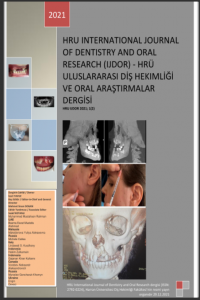Abstract
It is extremely difficult to diagnose muscle hypertonia due to the variety of clinical manifestations and patients’
complaints, and since the disease is often chronic and prolonged, and pain can radiate to any part of the head and neck. Our
study is aimed to propose the unique diagnostic algorithm of the masticatory muscles hypertonia as there is not any. We
involved and examined 189 patients with the developed diagnostic algorithm. The patients’ examination included the survey,
taking the life history and anamnesis, the psychoemotional status assessment. The clinical examination was carried out in
two stages. At the first stage, the dental status was determined, masticatory muscles were palpated to find out the involuntary
muscle contractions. At the second stage, the functional status of the muscles was assessed using additional research
methods (electromyographic, ultrasound and laser Doppler flowmetric study). Results. To apply the main and additional
methods while patients’ examinations at a dental appointment will allow to identify the masticatory muscle hypertonia at an
early stage, as well as to determine the etiopathogenetic and physiological aspects of this pathology development.
Conclusion. The presented diagnostic algorithm of the masticatory muscle hypertonia contributes to a critical understanding
of the provisional diagnosis or to accidentally muscle hypertonia detection
References
- 1. Beddis H, Pemberton M, Davies S. Sleep bruxism: an overview for clinicians. - Br Dent J. - 2018; 225(6):497-501. PMID: 30237554
- 2. Ella B, Ghorayeb I, Burbaud P, Guehl D. Bruxism in Movement Disorders: A Comprehensive Review. - J Prosthodont. - 2017;26(7):599-05. PMID: 27077925.
- 3. Kuhn M, Türp JC. Risk factors for bruxism. - Swiss Dent J. - 2018;128(2):118-24. PMID: 29533049.
- 4. Guo H, Wang T, Niu X, Wang H, Yang W, Qiu J, Yang L. The risk factors related to bruxism in children: A systematic review and metaanalysis. - Arch Oral Biol. - 2018;86:18-4. PMID: 29149621.
- 5. Gouw S, de Wijer A, Creugers NH, Kalaykova SI. Bruxism: Is There an Indication for Muscle-Stretching Exercises? - Int J Prosthodont. - 2017;30(2):123-32. PMID: 28267818.
- 6. Vavrina J, Vavrina J. Bruxismus: Einteilung, Diagnostik und Behandlung [Bruxism: Classification, Diagnostics and Treatment]. - Praxis (Bern 1994). - 2020;109(12):973-8. PMID: 32933386.
- 7. Cavallo P, Carpinelli L, Savarese G. Perceived stress and bruxism in university students. - BMC Res Notes. - 2016;9(1):514. PMCID: PMC5178076.
- 8. Vorobev A.A., Makedonova Yu. A., Aleksandrov A. V., Sosulya E. Yu. Gnatic device / Patent No.RU 2744236 effective from 04.03.2021 (In Russ.).
- 9. Makedonova Yu. A. Vorobyov A. A, Osyko A. N., Alexandrov A.V., Pavlova-Adamovich A. G., Stavskaya S. V. Justification of the use of a pneumotenager-rotorasshirator in patients with hypertonus of the masticatory muscles.- Medical Alphabet.– 2021;12: 72-8. (In Russ).
- 10. Makedonova Yu. A., Vorobyev A. A., Alexandrov A.V., Osyko A. N., Pavlova-Adamovich A. G. Electromyographic indicators of masticatory muscles in children with cerebral palsy / Certificate of state registration of the database No. 2021621050 dated 21.05.2021.
- 11. Butova A.V., Itskovich I.E., Silin A.V., Sinitsina T.M., Maletskiy E. Yu., Kakheli M.A. MRI possibilities of the masticatory muscles alteration diagnostics at musculoarticular temporomandibular joint dysfunction herald of north-western state medical university named after I.I. Mechnikov. – 2016; 8(3): 13-18.(In Russ.)] eLIBRARY ID: 27470076
- 12. Makedonova Yu. A., Vorobyev A. A., Alexandrov A.V., Dyachenko D. Yu. Screening-diagnostics of masticatory muscle hypertonus in adults / / Certificate of registration of the database No. 2021621703 of 11.08.2021, application No. 2021621557 of 29.07.2021 (In Russ.)
Abstract
References
- 1. Beddis H, Pemberton M, Davies S. Sleep bruxism: an overview for clinicians. - Br Dent J. - 2018; 225(6):497-501. PMID: 30237554
- 2. Ella B, Ghorayeb I, Burbaud P, Guehl D. Bruxism in Movement Disorders: A Comprehensive Review. - J Prosthodont. - 2017;26(7):599-05. PMID: 27077925.
- 3. Kuhn M, Türp JC. Risk factors for bruxism. - Swiss Dent J. - 2018;128(2):118-24. PMID: 29533049.
- 4. Guo H, Wang T, Niu X, Wang H, Yang W, Qiu J, Yang L. The risk factors related to bruxism in children: A systematic review and metaanalysis. - Arch Oral Biol. - 2018;86:18-4. PMID: 29149621.
- 5. Gouw S, de Wijer A, Creugers NH, Kalaykova SI. Bruxism: Is There an Indication for Muscle-Stretching Exercises? - Int J Prosthodont. - 2017;30(2):123-32. PMID: 28267818.
- 6. Vavrina J, Vavrina J. Bruxismus: Einteilung, Diagnostik und Behandlung [Bruxism: Classification, Diagnostics and Treatment]. - Praxis (Bern 1994). - 2020;109(12):973-8. PMID: 32933386.
- 7. Cavallo P, Carpinelli L, Savarese G. Perceived stress and bruxism in university students. - BMC Res Notes. - 2016;9(1):514. PMCID: PMC5178076.
- 8. Vorobev A.A., Makedonova Yu. A., Aleksandrov A. V., Sosulya E. Yu. Gnatic device / Patent No.RU 2744236 effective from 04.03.2021 (In Russ.).
- 9. Makedonova Yu. A. Vorobyov A. A, Osyko A. N., Alexandrov A.V., Pavlova-Adamovich A. G., Stavskaya S. V. Justification of the use of a pneumotenager-rotorasshirator in patients with hypertonus of the masticatory muscles.- Medical Alphabet.– 2021;12: 72-8. (In Russ).
- 10. Makedonova Yu. A., Vorobyev A. A., Alexandrov A.V., Osyko A. N., Pavlova-Adamovich A. G. Electromyographic indicators of masticatory muscles in children with cerebral palsy / Certificate of state registration of the database No. 2021621050 dated 21.05.2021.
- 11. Butova A.V., Itskovich I.E., Silin A.V., Sinitsina T.M., Maletskiy E. Yu., Kakheli M.A. MRI possibilities of the masticatory muscles alteration diagnostics at musculoarticular temporomandibular joint dysfunction herald of north-western state medical university named after I.I. Mechnikov. – 2016; 8(3): 13-18.(In Russ.)] eLIBRARY ID: 27470076
- 12. Makedonova Yu. A., Vorobyev A. A., Alexandrov A.V., Dyachenko D. Yu. Screening-diagnostics of masticatory muscle hypertonus in adults / / Certificate of registration of the database No. 2021621703 of 11.08.2021, application No. 2021621557 of 29.07.2021 (In Russ.)
Details
| Primary Language | English |
|---|---|
| Subjects | Dentistry |
| Journal Section | Research Articles |
| Authors | |
| Publication Date | December 29, 2021 |
| Published in Issue | Year 2021 Volume: 1 Issue: 2 |


